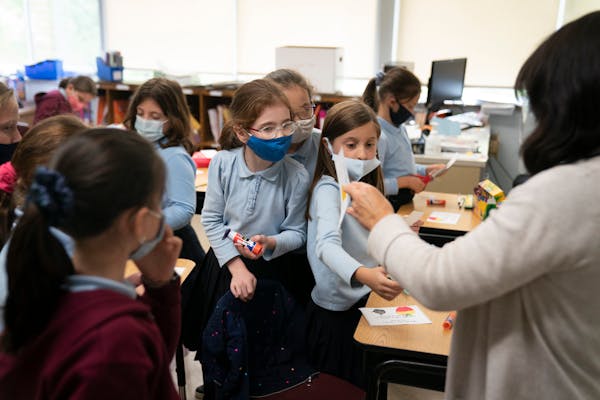Enrollment in Minnesota's public schools dropped by 2% for this school year, as many parents chose private school, home schooling, or postponed their students' first year because of pandemic-related concerns.
The decline, which was most pronounced among younger students, has major budget implications for districts already struggling with the added and unexpected costs of operating this year. Because each student accounts for about $10,000 in state funding, even relatively small enrollment losses add up to big budget gaps.
Districts that saw double-digit percentage declines in their student populations are now making plans for major cuts to staff, class offerings and school programs. Many are hoping for some relief from the Legislature but expect that even a multimillion-dollar aid package may not be enough to fill in the holes or account for uncertainty about how many students will return.
The Menahga Public School District, northwest of Brainerd, saw the most precipitous enrollment drop in the state: 20%. Superintendent Kevin Wellen said his district has already had to drain much of its reserve fund and expects to cut about 10% of its staff next year. Facing uncertainty about the pandemic, extra state funding, and how many students will return in the fall, Wellen said planning is harder than ever.
"It is a wild roller coaster," he said.
Before the pandemic, the Minnesota Department of Education had projected enrollment for the 2020-21 school year would be up from the previous year, though not growing quite as fast as in recent years. But the data released by the department Friday show that many families, especially those with younger students, and white students, adjusted their plans.
Kindergarten divergence
Statewide, kindergarten enrollment at public schools fell by 9%, as private schools reported a 12% increase. Many kindergartners were unaccounted for because Minnesota's mandatory age for school enrollment is 7. That means families who turned to home schooling or are waiting to start with first grade did not need to report those plans to the state.
Families who passed on public school were often looking for very different options. Some, especially with younger students, sought schools they thought would remain open for in-person instruction during the pandemic. Others wanted to sidestep the potential for unpredictable swings between distance, hybrid and in-person learning models — or avoid the possibility of in-person learning at all, until the pandemic had subsided.
St. Rose of Lima Catholic School in Roseville was among the private schools that saw a surge of interest last summer. The school's K-8 enrollment was up 73% this year and could have grown even more. To keep COVID-19 risks low, the school capped class sizes and put families on waiting lists.
Sean Slaikeu, the school's principal, said it looks like the trend will continue, at least for now. Nearly all of the new families who enrolled this year have already registered for fall.
"I think COVID was the catalyst that got parents to think: What other options are out there?" Slaikeu said.
Despite major gains in the early grades, however, K-12 private school enrollment was up by only about 1%, with enrollment declines at secondary schools.
In some districts, including Menahga, home schooling was the primary option for families who left public schools. Statewide, home school enrollment surged in the 2020-21 school year by nearly 50%. Other students moved into other public districts or charter schools because of their virtual offerings. Enrollment at public online schools — those set up as full-time virtual academies, not the distance learning option provided by districts this year — was up 69% over last year.
Hoping for a rebound
White students accounted for the majority of enrollment losses at public schools, with a decline of about 4%. Enrollment was up slightly among students of color, with gains among every racial group except Asian students. The number of white students in Minnesota's public schools has been declining for several years, but the drop was steeper this year than in the past.
Those trends were visible in many districts, including Robbinsdale, where districtwide enrollment dropped by 6%, one of the largest declines in the metro. (Only Burnsville and South St. Paul, which had a 7% drop, were higher.) In Robbinsdale, white students accounted for 63% of the decline, though they make up about a third of the district's student population.
Interim Superintendent Stephanie Burrage said families made decisions this year based on their own needs and concerns. Now, the district is focused on getting as many of them back as possible by highlighting things like its small class sizes and its arts program — all while grappling with a likely $4.4 million hole in the budget.
"We are looking at how do we market for students, so that parents know here's what we have to offer, what is happening in Robbinsdale," she said.
District leaders across the state are anxious to see what happens with proposals in the Legislature aimed at softening the blow of enrollment losses. Gov. Tim Walz's budget includes $25 million in one-time funding to help fill those gaps, while another bill would use prepandemic student counts to determine funding.
State Education Commissioner Mary Cathryn Ricker said in a statement that Minnesota should aim to prevent schools and students from suffering bigger losses.
"We have hope that our public school enrollment will rebound as Minnesota recovers from the pandemic," she said. "Until then, we will continue to do everything we can to ensure our public school systems are providing our students the education they need and deserve."

Want to share info with the Star Tribune? How to do it securely

'Safe recovery sites' would offer syringes, naloxone and more to people using drugs. The plan could be in peril.
New Minnesota GOP leaders seek peace with party's anti-establishment wing

Who is Republican Lisa Demuth, Minnesota's first House speaker of color?

